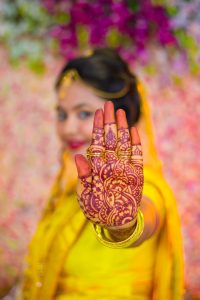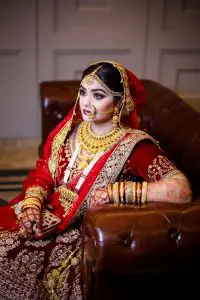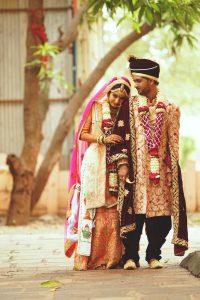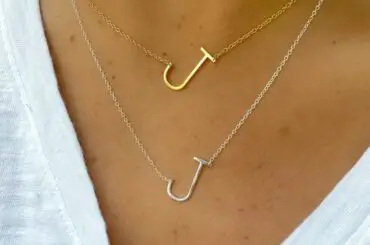Bridal jewelry is regarded as a fusion of spiritual and cultural essences for the most extraordinary and lovely occasion of a woman’s life. In India, bridal jewelry has exceptional value, and a bride’s look depends significantly on the jewelry she wears. Without her solah shringar, which contains all the jewelry a bride needs to be accessorized, an Indian bride is thought to lack makeup. Tradition, trends, and style influence each bride’s clothes on her special day. With the popularity of vibrant, glittery designs, more and more bridal looks are also incorporating other jewelry types like Kundan, Lac, and Jadau.
 Indian brides seem to shine thanks to the gorgeous jewelry that highlights them from head to toe. The following list captures the essential pieces that no Indian bride would be without on her wedding day.
Indian brides seem to shine thanks to the gorgeous jewelry that highlights them from head to toe. The following list captures the essential pieces that no Indian bride would be without on her wedding day.
Contents
Payal or Anklets
An anklet or Payal and toe rings are essential components of Indian bridal jewelry in different cultures of India. An anklet, a traditional piece worn around the ankles, is meant to announce the arrival of the new bride in her husband’s house with its tinkling sound. It is also scientifically connected to keeping the reproductive organs in a woman’s body in good health.
Bichiyas or toe rings
Toe rings are a traditional symbol of marriage in India and are worn on the second toe of each foot. They are made of ornately decorated silver and are usually made in two pieces, one for each toe.
Wedding ring
The wedding ring, worn on the left hand’s third finger, is a priceless ornament. Ancient Romans believed that the vein in that finger runs directly to the heart, which is why wedding rings are worn on that particular finger only. Brides are expected to attend the ceremony wearing their engagement rings. It is a custom. They might wear additional ones that match their clothing and have colorful stones.
Choora or Bangles
Every Indian bride adores wearing bangles because the word makes a lovely tinkling sound. Various designs are available in bangles. One can get it made in gold or a gold bangle with diamond studs. Some brides opt for diamond bangles as it goes wonderfully with light-colored bridal wear. The use of Kundan gives an intricate design to the bangles, mainly done by an amalgamation of gold and uncut diamonds.
Earrings
Earrings are like the best friends of a bridal necklace, and both complement each other. Heavy designs and intricate patterns are in right now. “Required attire” includes earrings.” so a bride must consider comfort when selecting them. The word ‘Jhumki’ refers to India’s traditional bell-shaped earring design.
Maang Tikka
Another significant representation of a woman’s status as a bride is the maang tikka. It is held by a hook at the center parting of her hair, with the pendant falling on the center of the forehead. The chakra where it lands is thought to be the Ajna chakra, which in Sanskrit means “knowing or realizing.”
Necklace
A bride wears necklaces as neckpieces on her wedding day. Brides prefer wearing necklaces made of gold but with a colorful and glittery touch of Kundan and diamond. One of the neckpieces is a mangalsutra, which the groom puts around her neck during the marriage ceremony. The wife, after that, wears it as long as she or her husband is alive as a sign of their commitment to one another.
Naath or Nose Ring
Nath or nose ring is one of the more unique items of Indian bridal jewelry. Its impressive past dates back to the Mughal Empire. Ayurveda claims that women with their nose pierced on the left side experience less menstrual pain and easier childbirth. In some states, the size of the nath also represents the financial power of her in-laws. But did you know that a nose ring, also known as a nath, is typically used to symbolize a bride’s virginity?
Kamarbandh or Waistband
Waistbands come in various styles, from curvy and broad to slim and delicate. They owe their renewed popularity to the fact that they enhance the beauty of the torso. Some say they lend an angelic or heavenly quality to a bride. From heavy and broad waistbands to slimmer ones, brides have started opting for wide varieties. The ornament is designed to allow you to hold a bunch of keys, thus signifying the assumption of authority at the bride’s new home.
Nallunge, or traditional cleansing ceremony
The traditional cleansing ceremony, or Nallunge, is completed the day or a few days before the wedding ceremony. Before the bride and groom take a cleansing bath during the ceremony, turmeric, sandalwood paste, and oil are applied to them. Traditionally, favors such as sweets, betel leaves, nuts, fruits, colorful jewelry and bangles are arranged on trays and presented before the bride.
Wedding ceremony
The main pieces of jewelry worn by Indian brides are Maang Tikka (headpiece jewelry), Jhimki (earrings), thick bangles, layered necklaces, rings, and Ottiyanam (saree belt). Gold rings and chains are the most common jewelry accessories worn by grooms. Although customs and cultures have changed over time, bridal jewelry is essential to Indian weddings.
An Indian priest is usually appointed to conduct a Hindu wedding ceremony. At the culmination of the ceremony, the guests present are given handfuls of yellow rice and other grains, which are tossed or showered in pairs to bless them for a prosperous married life. Then the father of the bride hands it over to the groom.
The Thaali or Mangala Sutra tying highlights an Indian Wedding Ceremony. The tying of the Thaali necklace signifies the inseparable union of the married couple.
The Thaali is a sacred necklace the Hindu groom ties around the bride’s neck. Once the groom ties the Thaali necklace around the bride’s neck, they are officially married.
As a sign of union, after tying the Thaali, the groom takes the bride’s hand. The couple then exchanged vows during this ritual, sometimes called the Seven Step ritual. The Seven Step ritual outlines the happy couple’s lifelong commitment, devotion and mutual respect.
Jewelry plays an important and symbolic role in Indian weddings as each has its significance in culture and ethnicity.





